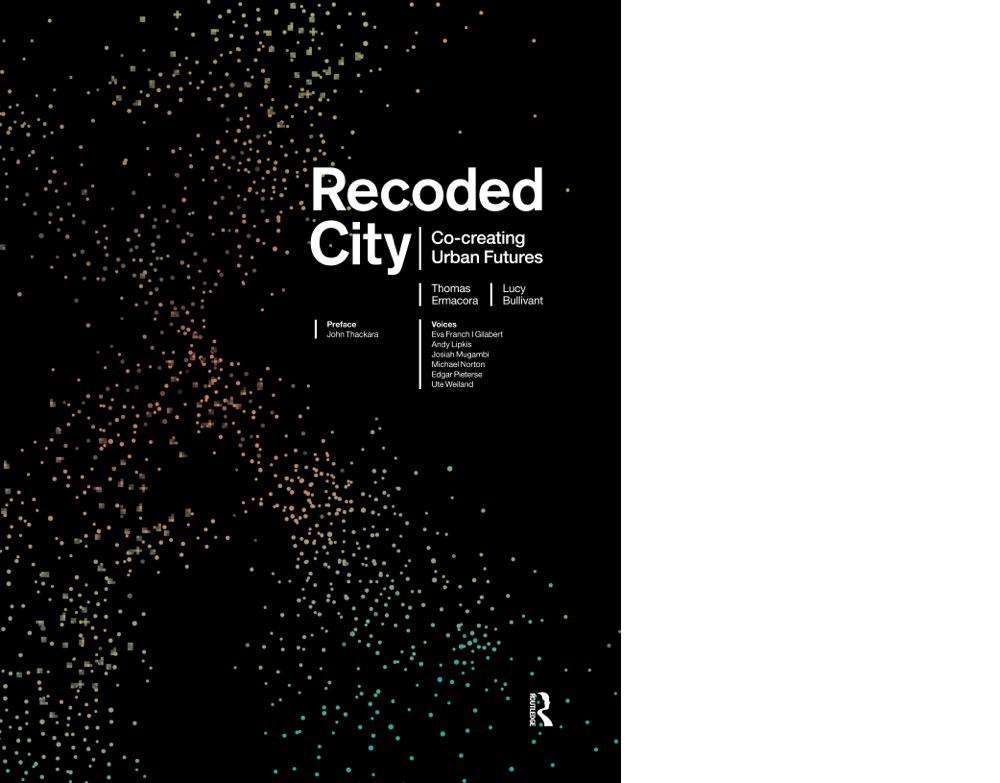by: ac
Thomas Ermacora made a Wizard of Oz-like video appearance during the October Oculus Book Talk on 09.12.16. He explained that Recoded City: Co-creating Urban Futures, the book he has co-authored with Lucy Bullivant, Ph.D., Hon. FRIBA, was intended to be a resource and compendium for activists who work in “bottom-up” participatory placemaking. The reality is that the book is much more – it is an ambitious mechanism to enable the public to change the way our cities and towns operate.
The monthly book talk was physically imparted by Bullivant, joined by Adam Lubinsky, Ph.D., managing principal, WXY architecture + urban planning; Alex Alaimo, Assoc. AIA, founder, Operation Resilient Long Island (ORLI); and William Menking, editor-in-chief, The Architect’s Newspaper, who arrived to moderate a discussion. Much like the activity of participatory design, there were many people coming and going, adding challenging prompts and provocations to the conversation.
The content of Recoded City is clearly demarcated by two types of paper: a light, pink-colored newsprint holds Ermacora and Bullivant’s narrative, and a more traditional paper for the very comprehensive case studies, orchestrated by Bullivant. All components of the book are handsomely designed, with infographics and data deployed through both tones of text. The result of the disjuncture of the book is that is does have more of a “workbook” or “handbook” type of feel, rather than didactic expository. It is suited to the wiki age, where dipping into information out of context is the norm. But both Ermacora and Bullivant are much brighter than that. Their writing is quick and direct, taking the reader confidently through the history of urbanism, where Jane Jacobs and Jan Gehl are of primary importance. Surprisingly, they also take us through a “history” of the DIY movement, the genesis of the wiki culture, and the potential urban implications of hacking, transparency, and self-organization. The authors explain how these offshoots, derived from DIY culture, have impacted the nature of urban evolution, and how this brand of empowerment has shifted from the individual to a community-based ideal. The feat of intellectually dovetailing the traditional definitions of urbanism and, for that matter, traditional definitions of participatory design with the role of virtual interconnectivity and open sourcing, is eye-opening. This should be required reading in all design curriculums.
The diagrams embedded throughout the text hold more than the average fashionable data graphic. They are a marvelous device to lay out alternative approaches to organization, the most hopeful and helpful being a sheet illustrating “Improving consultation methods for master planning.” This clear diagram of process accompanying the narrative makes a brilliant case for community-based placemaking. None of the actual information is new, but the clarity of purpose emphasizes investment in and engagement of all stakeholders.
The case study or “Stories” section, as the authors refer to it, is fascinating. Many of the projects have been published and analyzed by other urbanists, but the breadth of the projects is the edifying component. The projects jump from discussions of Friends of the High Line to Kéré Architecture’s descriptions of community-made mud floors. This inclusiveness is why the book is so necessary. The new community activist needs both information on mud floors as well as how to rally a wildly wealthy base to accomplish the lovely level of placemaking that Recoded City holds up as exemplars.
This is a hopeful book, written prior to the Brexit vote and the current state of the U.S. presidential election. Let us hope that the values of transparency and a people’s participatory ethos can weather the storm of both. This book may well be a source for a level of activism that moves from necessary to imperative.








